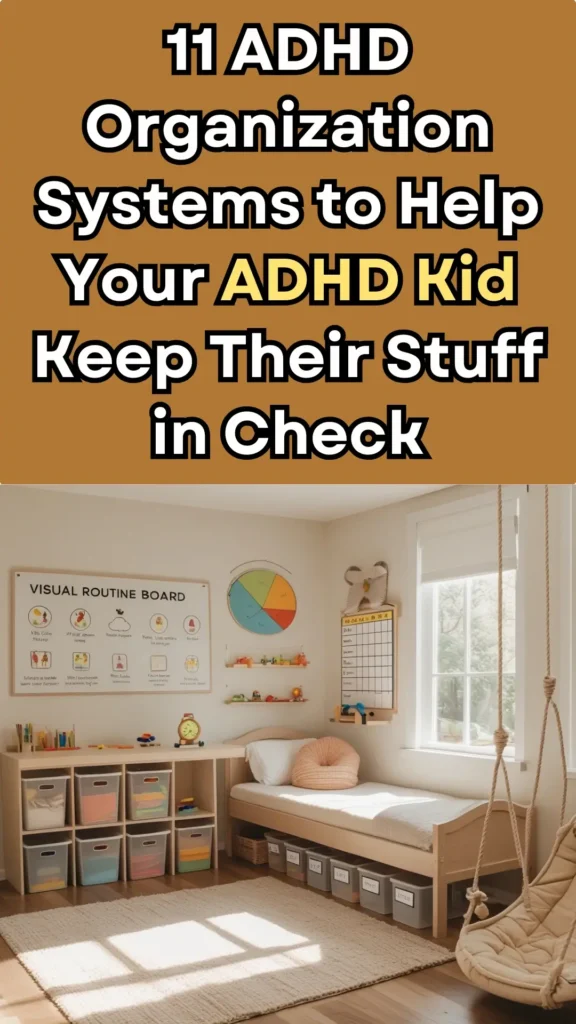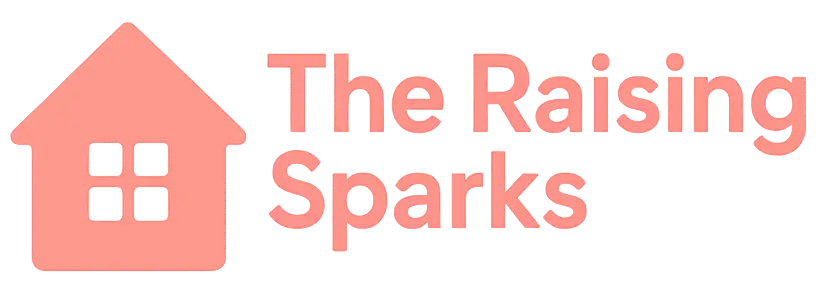From toys to school supplies, these ADHD-friendly organization systems help your child stay in control without you needing to constantly remind them.
Don’t forget to save this pin for later!

Let’s be real for a sec.
If you’ve got a child with ADHD, you already know that “just put your stuff away” isn’t a one-and-done lesson.
Shoes go missing in the house. School papers vanish between the car and the table. Half the Lego bin ends up under the couch… again.
And you? You’re left wondering if there’s a better way. Something that works with their brain, not against it.
The good news? There is.
These 11 organization systems aren’t magic. But they are practical, doable, and rooted in what actually helps ADHD kids manage their stuff and their space with more calm, control, and independence.
(P.S. If you’re also someone with ADHD yourself? These tips help grownups too. No judgment. We’re all in this together.)
1. Give Everything a Home (That Makes Sense to Your Kid)
ADHD brains lose things easily. Not because they’re careless, but because “where it goes” often doesn’t stick.
Help your child decide together where things will live: earbuds, water bottles, homework folders, sports gear. Then label it clearly. Bonus if it’s visual and easy to spot.
Think: open bins instead of drawers, wall hooks instead of closets. The goal is easy in, easy out.
2. Create a Visible Launch Pad
Designate a space near the exit door where everything for the next day gets placed the night before. Backpack, library book, sports shoes (all of it).
If it’s in the line of sight, it’s more likely to get remembered. If it’s buried under stuff? Gone forever (probably under the car seat).
Make it routine: “launch pad check” before bedtime.
3. Use Visual Reminders Everywhere
Out of sight = out of mind for a lot of ADHD kids. Visuals are game-changers.
Sticky notes on the door (“grab lunchbox”), whiteboard calendars, picture-based chore charts, even masking tape labels. These little cues help kids stay on track without needing 10 reminders from you.
Make it colorful, bold, and simple. The goal isn’t Pinterest-pretty. It’s brain-friendly.
4. Declutter the Spaces That Stress Them Out
More stuff = more stress. ADHD kids get overwhelmed fast by cluttered bedrooms or chaotic desks.
Keep only what they truly use. Store the rest or donate it.
Set up a weekly “10-minute reset” where you clear one area together. Make it playful (music on, timer set, toss things into a donate box like it’s a game).
5. Keep Systems Super Simple
If it takes more than 2 steps to put something away, it probably won’t happen.
Use lidless bins, open shelves, and catch-all baskets. Forget organizing socks by color. One bin for all of them is enough.
Simple systems = systems that stick.
6. Make Cleanup a Daily Habit (But Keep It Short)
Instead of saving cleanup for “one big weekend project,” do 5- to 10-minute daily resets.
Call it a “room rescue” or “power tidy.” Use timers, upbeat music, or race-the-clock games.
When it’s part of the rhythm, it doesn’t feel so overwhelming.
7. Use Routines That Repeat (So They Don’t Have to Rethink Every Day)
Predictability soothes chaos. Set up routines for mornings, after school, and bedtime. Even a simple checklist can anchor the day.
Tape them up somewhere visible. Bonus points for using your child’s words or drawings.
When the day has a flow, they feel safer. And you do too.
8. Designate a Homework Zone That Actually Works
A quiet-ish space, with minimal distractions and everything they need already there (pencils, calculator, water, fidget toy?).
This isn’t about Pinterest-worthy setups. It’s about removing friction. Fewer trips to “just grab one thing” = fewer rabbit holes.
If your child likes background noise or needs headphones, include that. Customize it to them.
9. Use End-of-Day Checklists
Kids with ADHD often forget what to bring home, what needs to go in the bag, what’s due tomorrow.
A quick visual checklist taped inside their planner or binder can help:
📚 Got your homework? 📅 Any notes from school? 🔄 Do you need to ask the teacher anything?
Repetition makes recall easier. And builds independence over time.
10. Protect Their Energy with Margin and Downtime
Overscheduling leads to meltdown city. ADHD kids need buffer time between school and homework, between chores and bedtime.
Say no to too many back-to-back activities. Leave space to decompress, snack, stretch, do nothing.
Downtime isn’t lazy. It’s regulation.
11. Celebrate What Is Working (Out Loud)
It’s easy to notice what’s still messy. But when your child remembers to use the launch pad? Or clears their space without a reminder?
Say it out loud. Name the win. ADHD kids often hear more about what they forgot than what they nailed.
Your encouragement = fuel for their growth.
💬 Real Talk Before You Go
Helping a child with ADHD stay organized isn’t about perfection.
It’s about progress. Bit by bit. System by system. Habit by habit.
Some days it’ll feel like it’s all working. Other days, the Legos will be back under the couch and the planner will be missing (again). That’s okay.
Whether you’ve got ADHD yourself or you’re just trying to keep up with the beautiful chaos your child brings, these systems are for you too.
Take what works. Leave what doesn’t. You’re not alone in this.
If this post helped, save it. Come back to it when things feel extra messy.
You’ve got this. And your kid does too.
